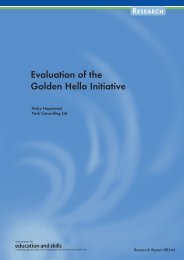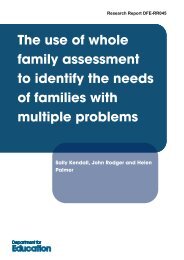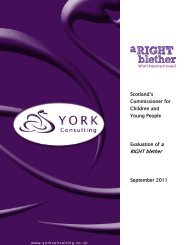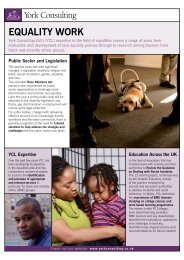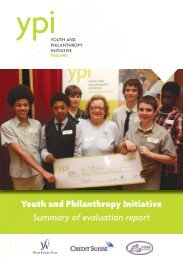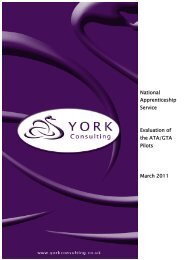Recruitment and Retention in the Post-16 Learning and Skills Sector
Recruitment and Retention in the Post-16 Learning and Skills Sector
Recruitment and Retention in the Post-16 Learning and Skills Sector
Create successful ePaper yourself
Turn your PDF publications into a flip-book with our unique Google optimized e-Paper software.
• levels of satisfaction with <strong>the</strong> amount <strong>and</strong> quality of resources <strong>and</strong>facilities available to staff is very high (69% <strong>and</strong> 76% respectively).A m<strong>in</strong>ority of staff <strong>in</strong>dicated dissatisfaction with <strong>the</strong> amount <strong>and</strong>quality of resources <strong>and</strong> facilities available (21% <strong>and</strong> 15%respectively);• <strong>in</strong> terms of subjects, science, English <strong>and</strong> eng<strong>in</strong>eer<strong>in</strong>g,teachers/tra<strong>in</strong>ers reported lower levels of satisfaction with <strong>the</strong>amount <strong>and</strong> quality of resources compared with o<strong>the</strong>r subjectareas;• key concerns where resources were not satisfactory, related to ITfacilities be<strong>in</strong>g poor or lack<strong>in</strong>g, poor work<strong>in</strong>g conditions <strong>and</strong> lack ofequipment/up to date equipment;• just over two fifths of respondents (42%) reported that <strong>the</strong>y hadconsidered leav<strong>in</strong>g <strong>the</strong>ir current employment dur<strong>in</strong>g <strong>the</strong> last sixmonths.• of those respondents who had considered leav<strong>in</strong>g <strong>the</strong>ir present job,one third (33%) said <strong>the</strong>y had applied for o<strong>the</strong>r jobs dur<strong>in</strong>g <strong>the</strong>previous six months. Overall this represents 14% of <strong>the</strong> learn<strong>in</strong>g<strong>and</strong> skills workforce;• respondents who had actively applied for o<strong>the</strong>r jobs were morelikely to be dissatisfied with <strong>the</strong>ir current job, to be younger <strong>and</strong> tobe from black <strong>and</strong> m<strong>in</strong>ority ethnic groups;• well over half of respondents (57%) who had applied for o<strong>the</strong>r jobs<strong>in</strong>dicated that <strong>the</strong>y were pursu<strong>in</strong>g a job <strong>in</strong> a related sector with<strong>in</strong>education. Just over a third (34%) had sought a job <strong>in</strong> a completelydifferent sector;• <strong>the</strong> vast majority of respondents (83%) felt that <strong>the</strong>y would still bework<strong>in</strong>g for <strong>the</strong> same organisation <strong>in</strong> 12 months time;• three fifths of respondents felt <strong>the</strong>y had too much work to do, whileover a third (37%) reported that <strong>the</strong>y had <strong>the</strong> right amount of workto do. Managers were much more likely to <strong>in</strong>dicate that <strong>the</strong>y hadtoo much work to do compared with o<strong>the</strong>r types of staff. Similarly,staff work<strong>in</strong>g <strong>in</strong> fur<strong>the</strong>r education colleges, science subjects weremuch more likely to feel <strong>the</strong>y had too much work to do;• aspects of this perceived excessive workload <strong>in</strong>dicated by staff<strong>in</strong>cluded too much paperwork, bureaucracy <strong>and</strong> lack ofadm<strong>in</strong>istrative support.61



